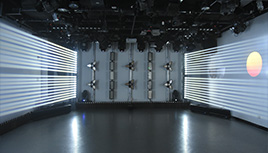How Gobo Projectors Can Elevate Your Landscape Lighting Design
Customizing Your Lighting Design
Gobo projectors provide the unique ability to project intricate and customizable patterns onto various surfaces such as walls, paths, trees, and water features. This flexibility enables lighting designers to create bespoke designs that align with the environment and theme of the space. Whether it’s projecting natural patterns, like leaves or ripples, or abstract designs that add artistic flair, gobo projectors are perfect for adding texture and depth to the landscape.
Enhancing Atmosphere with Image Projection
A key advantage of image projection lights in landscape design is their ability to set the mood of the environment. By using gobo projectors with dynamic patterns, designers can evoke different atmospheres—romantic, serene, energetic, or dramatic. Imagine the mesmerizing effect of gobo lights projecting moving water patterns on a garden pond or gently cascading leaves along a garden path, creating a captivating and immersive experience for those enjoying the space.
Branding and Unique Features
Beyond aesthetic design, gobo projectors offer practical applications in branding. They can be used to project company logos, event names, or themed images onto a building facade or outdoor venue. This gives lighting designers an opportunity to blend functional branding with visual art, creating a memorable and professional impact for any public or private space.
Energy Efficiency and Versatility
As sustainability becomes a priority in lighting design, gobo projectors provide an energy-efficient alternative to traditional lighting systems. Using LED technology, these projectors consume less power while providing vibrant, high-quality projections that last longer. Moreover, their versatility allows for easy changes in design, making it simple to update the lighting theme for different seasons, events, or occasions.
Here comes the detailed explanation of gobo projectors, focusing on key features such as brightness, beam angle, zoom functions, waterproof capabilities, and other technical aspects. Below is a detailed breakdown:
1. Brightness
- Functionality: Brightness is a critical factor in determining the effectiveness of a gobo projector. The brightness level of a gobo projector depends on its power output, measured in watts (W). High-powered projectors (e.g., 100W to 150W) are ideal for larger outdoor areas or high-visibility events.
- Example: A high-powered gobo projector used for projecting a company logo onto a large building façade can generate over 3000 lumens, ensuring the projection remains visible during both day and night.
- Data: LED-based projectors with over 100W power typically offer 2000-4000 lumens for professional-quality projections.
- Functionality: Beam angle determines how wide or narrow the light projection will be. A narrow beam focuses the projection into a sharp, detailed image, while a wider beam can cover a larger area, offering more versatile design possibilities.
- Example: A gobo projector with a 10° beam angle is ideal for projecting a focused logo on a building, while a wider 40° beam angle might be used to project broader patterns like leaves or clouds across a garden or plaza.
- Data: Adjustable beam angles between 10°-40° offer flexibility in both focused and broader projections.
- Functionality: Some advanced gobo projectors feature zoom capabilities, allowing users to change the beam angle, making the projected image larger or smaller as needed. This flexibility is essential for different spatial setups and design requirements.
- Example: A zoomable gobo projector can project a small, detailed logo during one phase of an event and switch to a larger design (such as a floral pattern) for a dramatic effect in a bigger outdoor area.
- Data: Zoom lenses typically adjust the beam angle from 10° to 40°, offering adaptability for dynamic setups.
- Functionality: Waterproof gobo projectors are crucial for outdoor installations exposed to weather conditions. The IP (Ingress Protection) rating determines how well the projector is protected from dust and water. IP65 is common for outdoor lighting fixtures, meaning the projector is fully dustproof and protected against low-pressure water jets.
- Example: A gobo projector with IP65 rating can be installed in an open-air garden or cityscape, projecting intricate leaf patterns on a rainy night, without the risk of water damage.
- Data: An IP65 rated projector can endure rain and dust while maintaining performance outdoors.
- Functionality: The projection surface affects how the image will appear. Many gobo projectors include image correction features that ensure the projected patterns are clear and undistorted, especially when projected onto curved or angled surfaces.
- Example: When projecting a logo onto a building with a curved façade, image correction technology ensures the logo appears aligned and straight, avoiding distortion from the curve.
- Data: Keystone correction is commonly used to fix image distortions when the projector is not placed directly perpendicular to the surface.
- Functionality: Gobos are customizable stencils or templates used in projectors to create patterns or logos. Glass gobos provide high detail and sharp edges, while metal gobos are more durable and used for simpler, bold designs.
- Example: A custom glass gobo can be created to project detailed botanical patterns, while a metal gobo might project a brand’s logo with high contrast.
- Data: Glass gobos are used for high-resolution designs, while metal gobos are ideal for high-contrast and durable projections.
- Functionality: The lifespan of a gobo projector is influenced by the type of lamp used (LED or traditional). LED-based gobo projectors are known for their longer lifespan, typically offering 20, 000 to 50, 000 hours of usage.
- Example: A LED gobo projector installed in a public park could run continuously for several years, with minimal maintenance, while traditional lamps might need replacement every 2, 000 hours.
- Data: LED gobo projectors last significantly longer than halogen lamps, reducing maintenance costs in large-scale or permanent installations.
- Functionality: Modern gobo projectors, especially those using LED technology, are more energy-efficient than older halogen-based models. They provide high-quality projections with lower energy consumption.
- Example: A 30W LED gobo projector could replace a 100W halogen unit, reducing energy consumption by up to 70%, which is ideal for energy-conscious projects.
- Data: LED gobo projectors consume approximately 50%-70% less energy than their halogen counterparts, making them an eco-friendly choice for large-scale lighting designs.














